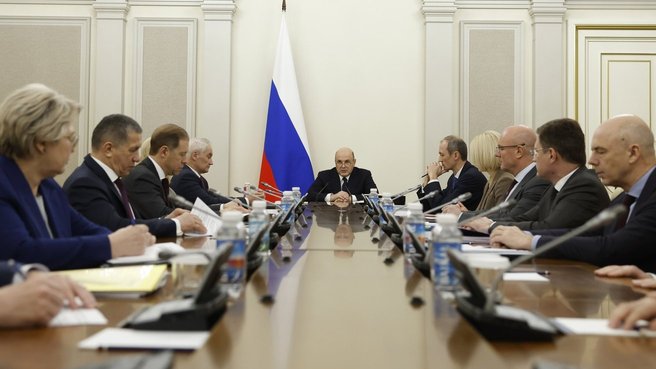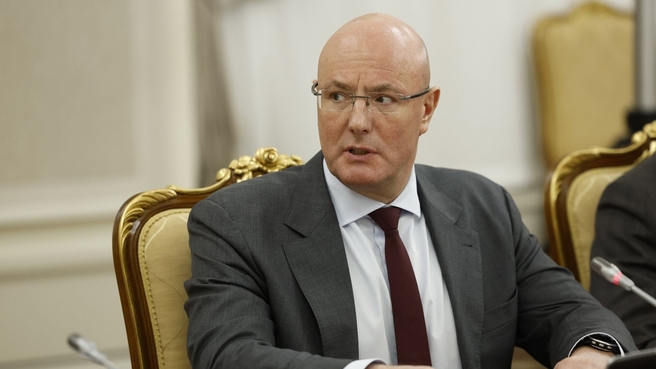Agenda: updating the long-term programme to promote young people's employment, and domestic tourism during the New Year holidays.
Mikhail Mishustin’s opening remarks
Dmitry Chernyshenko's report on domestic tourism during the New Year holidays
Excerpts from the transcript:
Mikhail Mishustin: Good morning, colleagues.
Let's start with labour market issues. The Government continues to create additional opportunities for citizens of all ages to find a job to their liking and develop their careers.
On the instructions of the President, we have updated the long-term programme to promote young people's employment, its implementation plan and relevant targets. The programme was approved about two years ago and is to run until the end of the decade.
Under the updated document, we will create conditions for girls and boys to decide on their future profession even before coming of age and gain the experience, skills and knowledge necessary for their future occupation.
For this purpose, we have provided for professional orientation of schoolchildren in grades 6–11, which will allow them to decide more quickly what field they wish to pursue. You know how important it is for young people to decide what they want to become.
Employment procedures, including temporary employment, will be optimised. And young people aged 14 to 18 will be able to learn practical skills in their spare time.
We will also continue to improve the Jobs of Russia platform. There and on the portal of government services we will post proposals for concluding target training agreements with prospective employers.
We believe that the implementation of this long-term programme will help our young people, graduates and newcomers to find appropriate vacancies and achieve success in their careers, and the economy will be provided with in-demand personnel.
Another topic concerns domestic tourism.
The President noted that this industry is reaching a new level. And we can all see it. It is becoming more attractive. Our citizens have formed a stable interest in holidays in Russia. And the flow of holidaymakers within the country is growing every year.
During the recent New Year holidays, people were very active in visiting the regions. Each of them has unique places. These are large cities with Christmas fairs, ice arenas, theatres, museums, natural attractions, as well as resorts where you can do winter sports and get health treatments.
Mr Chernyshenko, tell us more about what types of recreation and which regions were most popular with our citizens during the holidays. And in general, I would like to hear about the dynamics of the development of this sector.
Dmitry Chernyshenko: Mr Mishustin, colleagues.
Indeed, we see an impressive growth in demand for domestic tourism. The New Year holidays were no exception. Thus, according to preliminary data, the increase in the number of trips over last year's New Year holidays was more than half a million people (this is about a 19 percent increase), and the average hotel occupancy rate was more than 80 percent.
It is important that the tourism industry and the related services were ready for the peak load.
And most importantly, the New Year holidays passed quietly, without serious accidents, and our citizens were able to enjoy their holidays in different parts of the country.
The Ministry of Economic Development coordinated preparations for the festive events – together with the Emergencies Ministry, the Federal Service for the Oversight of Consumer Protection and Welfare, the Ministry of Internal Affairs, as well as the regions and city administrations.
I would like to note separately the work of the Ministry of Economic Development and the Ministry of Transport in coordinating their forecasts for tourist flows and transport schedules. During the New Year holidays, the transport industry served 5.7 million passengers.
This is the result of systematic preparation, and we really have a lot to thank our colleagues for. Our citizens see that the safety, comfort and level of service in Russia's tourism industry are growing.
Despite the high demand for travelling across the country, in general, which is very important, we have managed to avoid a significant increase in the cost of services. This is the result of constant monitoring, which, on your instructions, is conducted by the Ministry of Economic Development and the Federal Antimonopoly Service at the Government Coordination Centre.
The leading regions in terms of total number of tourists are traditionally Moscow, the Krasnodar Territory and St Petersburg, accounting for more than 35 percent of tourist trips.
The Caucasus, Altai, the Far East, the northwest, and the Murmansk Region in particular, show good growth rates. These are undoubtedly new points of growth in domestic tourism.
During the New Year holidays, more than 80,000 people went to Crimea, which is more than during the previous holidays. The republic continues to be one of the most visited regions of the country.
Ski resorts are also growing in popularity. This is primarily the Krasnodar Territory – almost 150,000 people visited it, which is 75 percent more than last year's figure.
Second was Sheregesh, and third, the resorts of the North Caucasus. These are followed by tourist destinations in Siberia, Altai and the Far East. Among the leaders in terms of tourist flow growth rate is a new ski resort in the Murmansk Region, with a 25-percent increase.
The regions prepared and held a large event programme for the holidays.
In 2024, Suzdal became the New Year's capital of Russia. From December 24 to January 8, festive events there were attended by 150,000 people. This is an impressive result for a city with a population of only 9,000 people.
And Veliky Ustyug – the birthplace of Father Frost – was visited by 30,000 people during the holidays. Major events were organised in St Petersburg, where the Christmas Fair attracted 312,000 people, and in the Irkutsk Region, where the Ice City Pure Water Happiness was visited by more than 55,000 people.
Holiday programmes were also organised for residents in the new regions, especially children, and not only in the capital cities. During the New Year holidays, more than 8,000 children from the new regions went to the Sverdlovsk Region for a New Year tree festival, and similar events were held in Mordovia and the Nizhny Novgorod Region.
To summarise, I would like to note that the joint efforts of the regions, relevant federal agencies and businesses, along with state support mechanisms, continue to tap Russia's enormous tourism potential. This is confirmed by the stable growth of tourist volumes and, most importantly, by feedback – positive feedback from our citizens.
Mikhail Mishustin: Thank you, Mr Chernyshenko. Tourism is a multifaceted area that has a very strong impact on related industries. We all need to do everything we can to further develop opportunities for domestic tourism in Russia. This includes, primarily, the creation of convenient infrastructure.
Our country is beautiful. And many of our citizens have a great desire, I know, to visit different places. And infrastructure: convenient roads, comfortable hotels, opportunities for proper meals and recreation – this will help us take a systematic approach to the development of such an important industry.








